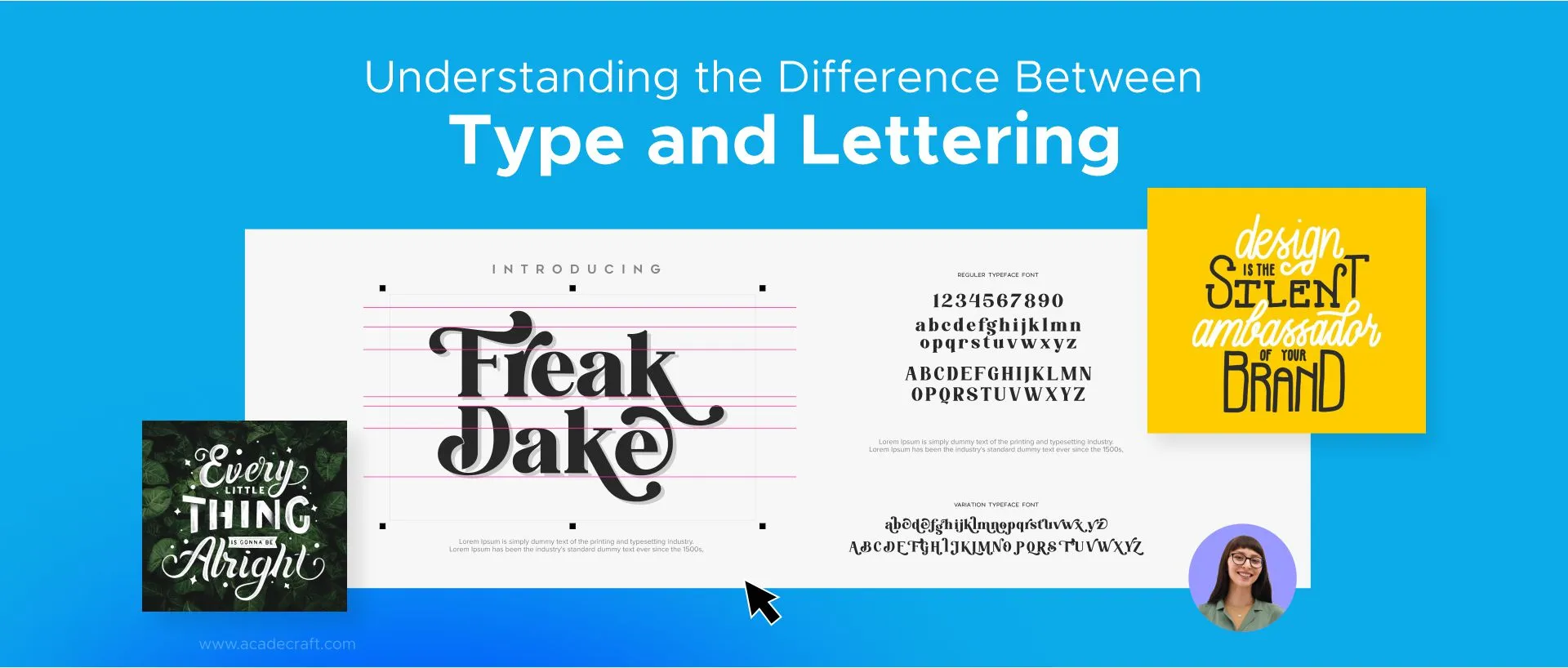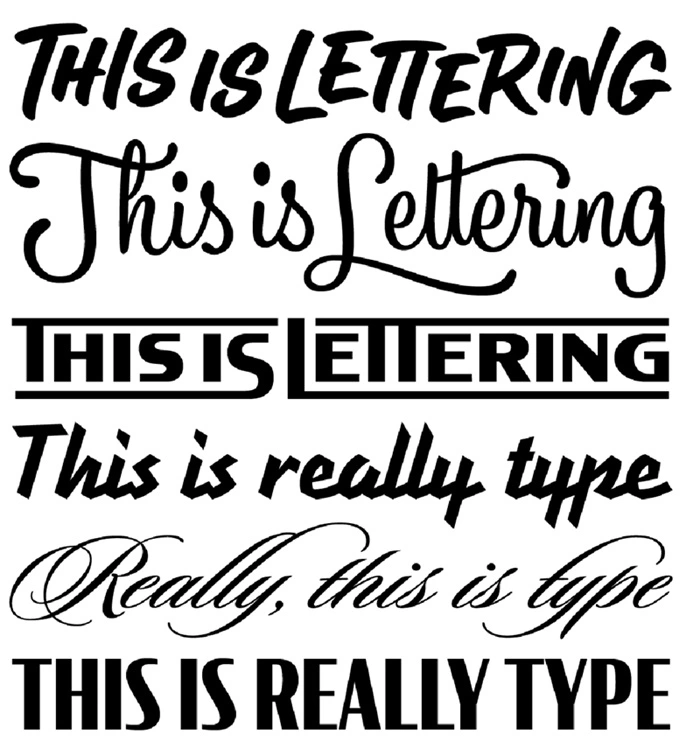
Have you ever wondered what sets type and lettering apart? In the arena of design, both may seem similar, but they actually serve different purposes and need special skills. Well, get ready to dive into the world of strokes and fonts.
From the soft handwritten calligraphy to the structured lines of digitally designed typefaces, understanding the fine differences between the two is crucial for any aspiring designer or enthusiast. In this essential guide, we will analyze some key differences between type and lettering.
Let us delve into the characteristics, techniques, and applications of the two skills. So grab your pens and keyboards because this is a lesson you won't want to miss!
Typography is known as the art and technique of arranging and designing type in a visually appealing and readable way. It involves selecting and arranging fonts, adjusting spacing and alignment, and considering factors such as hierarchy and legibility.
It plays a very important part in graphic design, advertising, web design, and print media, as it sets the tone and communicates the message of a piece. For example, in a poster or advertisement, the choice of font and its arrangement can evoke a certain mood or convey a particular message. A bold, sans-serif font may be used to create a modern and confident feel, while a script font can add elegance and sophistication.
Typography also helps to establish brand identity and recognition. Consistency in font usage across different platforms and materials helps to create a cohesive and memorable visual identity for a company or organization. This consistency can assist in building trust and credibility with customers and stakeholders.
Lettering refers to the art of drawing or creating custom letters and words manually using hands. It is a form of visual communication that combines elements of design, illustration, and calligraphy. Unlike typography, which focuses on the selection and arrangement of pre-existing fonts, lettering allows for more creativity and personalization.
It can be used to create unique logos, signage, book covers, and other visual materials that stand out and make a lasting impression. Lettering artists often use various tools and techniques, such as brush pens, markers, or even digital software, to bring their designs to life. Lettering artists often use various tools and techniques, such as brushes, pens, or markers, to bring their designs to life.
Bonus Read: Typesetting in Graphic Design
With the expansion of social media and digital marketing, lettering has become even more popular as it adds a personal touch to online content. Many lettering artists showcase their work on platforms like Instagram, attracting clients and building a strong following. It's fascinating to see the different styles and techniques used by lettering artists, from elegant and intricate scripts to bold and modern letterforms.
Image for reference:

Type and lettering are both forms of visual communication, but they serve different purposes and require different skills.
Type: It refers to the design and arrangement of printed or digital text.
Lettering: It refers to the art of drawing or creating individual letters.
For example, when you open a book or visit a website, the text you read is typically created using various typefaces. These typefaces are carefully designed to be legible and visually appealing, and they can be adjusted in size, weight, and style to convey different meanings or evoke specific emotions.
On the other hand, lettering involves creating unique hand-drawn or digitally crafted letters. It can be seen in custom logos, signage, or decorative headers in magazines. Lettering artists often use a combination of different techniques, such as calligraphy, brush lettering, or digital illustration, to create visually stunning and one-of-a-kind letterforms.
Unlike typefaces, lettering allows for more artistic freedom and personal expression, making it a popular choice for creating eye-catching designs that everyone can notice. Whether it's a beautifully hand-lettered quote or a meticulously crafted logo, lettering adds a touch of creativity and uniqueness to any project.
Typography and lettering are both important elements in modern design, but they serve different goals. Let us compare and contrast the two using tabular data.
|
Aspect |
Typography |
Lettering |
|
Definition |
The art and technique of arranging type. |
The creation of custom letterforms and designs, often by hand. |
|
Medium |
Utilizes pre-designed typefaces. |
Involves the creation of unique, custom letterforms. |
|
Flexibility |
Fixed and consistent, with variations limited to chosen typefaces. |
Infinitely flexible, allowing for custom designs tailored to the project. |
|
Application |
Ideal for large bodies of text, providing readability and consistency. |
Suited for logos, headlines, and designs where a unique touch is desired. |
|
Examples |
Newspapers, books, websites. |
Logos, signage, custom invitations. |
|
Creation Process |
Selection of typefaces and arranging them cohesively. |
Hand-drawn or digitally crafted letterforms, allowing for artistic expression. |
|
Consistency |
Ensures uniformity in branding and communication. |
Provides a unique, handcrafted feel, potentially varying from one instance to another. |
|
Scalability |
Highly scalable without loss of quality. |
Scaling may require adjustments to maintain visual integrity. |
|
Collaboration |
Easily integrates with other design elements. |
Requires more deliberate integration due to its unique and custom nature. |
|
Technology Dependence |
Relies on a variety of type design software. |
Combines traditional techniques with digital tools, depending on the artist's preference. |
|
Accessibility |
Generally more accessible for general use. |
Custom designs may pose challenges for certain applications, impacting accessibility. |
|
Trends in Modern Design |
Embraces minimalism, clean lines, and readability. |
Flourishes, hand-drawn aesthetics, and a return to custom craftsmanship. |
This section will provide some tips to help you decide whether to use typography or lettering for your project.
Consider the nature of the message you want to convey and the target audience. Typography is often preferred for conveying straightforward information, while lettering can add a personal and artistic touch. Tailor your choice to align with the tone and purpose of the design.
For example, if you are creating a poster for a corporate event, typography may be more appropriate to maintain a professional and clean look. On the other hand, if you are designing a wedding invitation, lettering can add a romantic and elegant feel to the design.
Clearly define the goals of your design project. If the emphasis is on readability, scalability, and a consistent visual identity, typography may be the go-to choice. For projects demanding a unique and expressive design, custom lettering can bring an exclusive flair. Consider the entire tone and message you want to convey through your design.
If you are aiming for a modern and minimalist aesthetic, typography can help in achieving a sleek and streamlined look. However, if your design calls for a more whimsical and playful approach, lettering can infuse personality and charm. At last, the choice between typography and lettering depends on the particular needs and objectives of your design project.
Assess the scope and constraints of your project. Tight timelines or extensive text content lean towards typography for efficiency. Lettering is a compelling choice for projects with a focus on individuality and bespoke design. Consider the purpose of the design project as well.
If you are creating a logo or branding materials, lettering can bring a unique touch and make your design stand out. On the other hand, if you are designing a website or publication with a lot of text, typography might be more practical and readable. It is important to consider the overall aesthetic and goals of your project when deciding between typography and lettering.
Interesting Read: Importance of Typesetting in Pre-Publishing for Every Author
Consider the option of blending both typography and lettering within your design. This harmonious combination can offer the best of both worlds, providing a structured foundation with the clarity of typography while incorporating unique, handcrafted elements through lettering. Striking the right balance can result in a visually appealing and effective design.
Not only does blending typography and lettering offer a visually appealing design, but it also allows you to make informed decisions that align with industry standards. By incorporating unique, handcrafted elements through lettering, you can create a design that can attract the audience in your specific niche. This combination provides a structured foundation with the clarity of typography, ensuring that your message is effectively communicated to your audience.
Look at case studies of successful designs within your niche. Analyze how typography and lettering have been effectively used in similar contexts. Understanding real-world examples will provide insights into what works well and guide you in making decisions aligned with industry standards.
For example, if you are designing a website for a tech company, you could look at case studies of successful tech websites and analyze how typography and lettering have been used effectively in those designs. It will give you a better understanding of what works well in your specific niche and help you make informed decisions that align with industry standards.
The difference between type and lettering is now well understood, and it is clear that both play a crucial role in design. Type brings consistency and readability, while lettering adds a personal touch and artistic flair. Understanding the distinction between the two allows designers to take advantage of their strengths and create visually stunning and impactful designs that resonate with their target audience.
To lead in the visual communication arena, you can take advantage of our expert typesetting services. By offering expert services, we can assist in typography and lettering. Whether it's ensuring consistency and readability through proper typographic techniques or adding a personal touch and artistic flair through custom lettering, we can help create visually stunning and impactful designs that resonate with the target audience. Let us support you in leading the way in visual communication.
Share